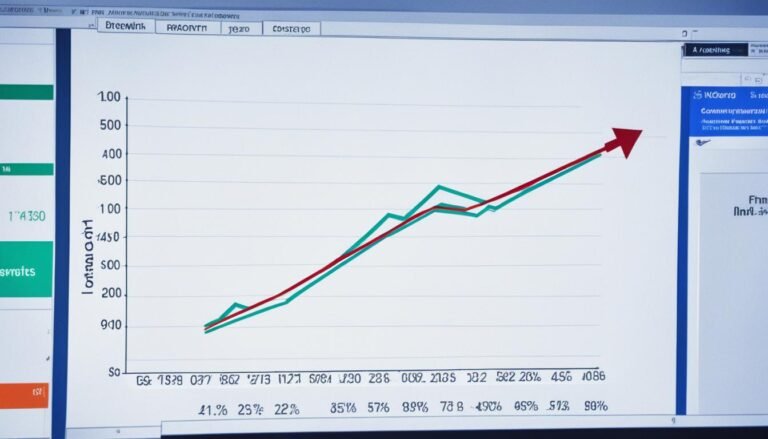Maximizing Gains with Portfolio Optimization Strategies
Portfolio optimization is a crucial aspect of managing investment portfolios effectively. It involves the careful selection of assets to achieve the highest possible return while considering the desired level of risk. By diversifying across various asset classes and balancing their weights, investors can create portfolios that align with their risk-reward objectives. With the application of portfolio optimization strategies, investors can maximize gains and enhance their overall investment outcomes.
Investment portfolio optimization is based on the principles of modern portfolio theory, which emphasizes the importance of diversification and the trade-off between risk and return. By constructing portfolios that consist of assets with different risk profiles, investors can manage risk and potentially optimize returns. This involves allocating investment capital across various asset classes, such as stocks, bonds, commodities, and cash equivalents, to achieve the desired risk- return outcome.
Key Takeaways:
- Portfolio optimization involves selecting the optimal combination of assets to achieve the highest possible return for a given level of risk.
- Modern portfolio theory and diversification play a crucial role in portfolio optimization.
- Asset allocation strategies help determine the optimal distribution of investment capital across different asset classes.
- Risk management strategies help assess and manage risk levels in a portfolio.
- Performance optimization strategies utilize various techniques to enhance risk-adjusted returns.
Understanding Portfolio Optimization
Portfolio optimization is a powerful technique that allows investors to maximize returns and minimize risks in their investment portfolios. It is based on the concepts of efficient frontier and modern portfolio theory, which provide a framework for creating well-balanced portfolios. Diversification strategies play a crucial role in portfolio optimization, as they help mitigate risks by spreading investments across different asset classes.
The efficient frontier refers to a portfolio that offers the highest possible returns for a given level of risk or the lowest possible risk for a desired level of return. It represents the optimal combination of assets that can be selected to achieve the best risk-reward outcome.
Modern portfolio theory highlights the importance of diversification in portfolio optimization. By investing in a wide variety of asset types and classes, investors can reduce their exposure to specific risks associated with individual assets. This diversification strategy helps to maximize returns by taking advantage of different systematic risks that affect various asset classes.
Diversification allows investors to optimize their portfolios by allocating capital across multiple asset classes, such as stocks, bonds, commodities, and real estate. Each asset class has its own risk and return characteristics, and by combining them in a portfolio, investors can achieve a more balanced risk-return profile.
For instance, stocks tend to have higher returns but also higher volatility, while bonds offer lower returns but lower volatility. By including both stocks and bonds in a portfolio, investors can potentially achieve higher returns while reducing overall volatility.
In summary, understanding the concepts of efficient frontier and modern portfolio theory, as well as implementing diversification strategies, is essential for successful portfolio optimization. By carefully selecting and balancing different asset classes, investors can aim to achieve their desired risk-reward trade-off and build well-diversified portfolios that are better prepared to weather market fluctuations.
Asset Allocation Strategies
Asset allocation plays a critical role in optimizing investment portfolios. By strategically allocating capital across different asset classes, investors can tailor their portfolios to their risk and return preferences. Here, we explore some popular asset classes and their characteristics.
Bonds
Bonds are debt instruments issued by governments and large organizations. They provide investors with regular interest payments over a fixed period of time, and the principal amount is returned upon maturity. Bonds are often considered safer investments compared to stocks because they offer stable income streams and lower volatility.
Stocks
Stocks represent ownership shares in publicly traded companies. They offer the potential for higher returns compared to bonds but also come with greater volatility and risk. Stocks can provide investors with capital appreciation and dividends, making them an attractive asset class for those seeking long-term growth.
Commodities
Commodities include physical goods or products such as oil, gold, and agricultural products. Visit Bullion Hub to explore investment opportunities in precious metals.
Commodities provide diversification benefits to a portfolio and can act as a hedge against inflation. Learning advanced techniques for gold and silver stacking can empower investors with the know-how to secure their wealth through tangible assets. Commodities tend to have a low correlation with other asset classes, making them a valuable addition to an investment portfolio.
Contracts
Contracts refer to financial instruments issued by private parties. These can include futures contracts, options contracts, and swaps. These instruments allow investors to gain exposure to underlying assets such as commodities, currencies, or stock indices. Contracts offer flexibility and the potential for leverage, but they also involve additional risks and complexity.
Cash and Equivalents
Cash and equivalents refer to liquid assets that can be readily converted into cash. These include bank deposits, money market funds, and short-term government bonds. Cash and equivalents provide stability and liquidity to a portfolio, enabling investors to seize attractive investment opportunities or meet short-term financial obligations.
Asset Allocation Strategies
Asset allocation strategies involve selecting the right mix of these asset classes based on an investor’s risk tolerance and investment goals. A well-diversified portfolio can help mitigate risk by spreading investments across different asset classes with varying risk and return profiles.
| Asset Class | Characteristics | Risk Level | Potential Return |
|---|---|---|---|
| Bonds | Stable income, lower volatility | Low | Modest |
| Stocks | Potential for capital appreciation, dividends | Medium to High | High |
| Commodities | Hedge against inflation, diversification | Medium to High | Varies |
| Contracts | Flexibility, potential for leverage | High | Varies |
| Cash and Equivalents | Liquidity, stability | Low | Low |
Each asset class offers its own unique advantages and risks. By allocating assets strategically, investors can optimize their portfolios to achieve their financial goals while managing risk effectively.
Risk Management Strategies
Risk management is an essential component of portfolio optimization. When investing, there is always a level of risk involved, as it is impossible to predict with certainty how an investment will perform. However, by employing effective risk management strategies, investors can minimize potential losses and maximize potential gains.
Risk can be defined as the possibility of losing money or not achieving expected returns on an investment. It is closely related to volatility, which refers to the degree of price fluctuation in an asset. Higher volatility indicates greater risk.
Volatility can be visualized as the ups and downs on a roller coaster. The higher and more frequent the peaks and valleys, the higher the volatility and risk. On the other hand, low volatility reflects a smoother, more predictable ride. Therefore, it is crucial for investors to understand and manage volatility to make informed investment decisions.
One risk management strategy is to assess and quantify an investor’s risk tolerance. Risk tolerance refers to an individual’s willingness and ability to endure potential losses in pursuit of higher returns. It is influenced by factors such as financial situation, investment goals, and time horizon. By understanding one’s risk tolerance, an investor can align their portfolio with their comfort level and avoid taking on excessive risk.
Another risk management strategy is to adjust the asset weights in the portfolio based on risk and return preferences. By diversifying investments across various asset classes, such as stocks, bonds, and commodities, investors can reduce the impact of individual asset performance on the overall portfolio. Diversification helps spread risk and protect against potential losses in any single investment.
Here is an example of a diversified portfolio:
| Asset Class | Allocation |
|---|---|
| Stocks | 60% |
| Bonds | 30% |
| Commodities | 10% |
By spreading investments across different asset classes, the portfolio has a reduced exposure to any single asset’s performance, thus mitigating risk. This diversified approach helps protect against volatility and optimize returns.
Furthermore, it is essential for investors to regularly analyze and adjust their portfolios to manage risk effectively. Monitoring the performance of investments and market conditions can provide valuable insights into potential risks and opportunities. By staying informed and proactive, investors can make informed decisions and adjust their portfolios accordingly.
Ultimately, effective risk management strategies are crucial for investors to navigate the complex world of investing. By considering risk tolerance, diversifying investments, and staying informed, investors can optimize their portfolios and achieve their financial goals.
Implementing risk management strategies is key to navigating the uncertainties of the investment world. By understanding risk, managing volatility, and diversifying investments, investors can protect their portfolios and optimize returns. The table below provides an overview of key risk management strategies:
| Strategy | Description |
|---|---|
| Assess Risk Tolerance | Evaluate individual comfort level with risk to align portfolio accordingly. |
| Diversification | Spread investments across various asset classes to minimize risk exposure. |
| Regular Portfolio Analysis | Monitor performance and market conditions to make informed decisions. |
By implementing these risk management strategies, investors can navigate the uncertainties of the market while aiming for optimal portfolio performance.
Performance Optimization Strategies
When it comes to optimizing the performance of your investment portfolio, employing the right strategies can make all the difference. Here are some key techniques that can help you enhance the risk-adjusted returns of your portfolio:
Mean-Variance Optimization
Mean-variance optimization is an extension of modern portfolio theory that takes into account both expected returns and risks. By considering these factors, mean-variance optimization enables investors to generate efficient portfolios that maximize returns for a given level of risk, or minimize risk for a desired level of return.
Monte Carlo Simulation
Monte Carlo simulation is a powerful statistical technique that models the probability distribution of different portfolio outcomes. This allows investors to assess the potential risks and returns associated with their portfolios. By understanding the range of possible outcomes, investors can make more informed decisions and tailor their strategies accordingly.
Factor-Based Investing
Factor-based investing leverages advanced mathematical models to identify factors that drive asset returns. These factors can include value, growth, momentum, and size, among others. By constructing portfolios based on these factors, investors can enhance diversification and potentially capture excess returns.
Here’s an example of how a factor-based investing strategy might diversify a portfolio:
| Asset Class | Weight |
|---|---|
| US Stocks | 25% |
| International Stocks | 25% |
| Bonds | 25% |
| Real Estate | 25% |
Portfolio Rebalancing
Portfolio rebalancing is an essential aspect of portfolio management. It involves regularly assessing and adjusting the composition of a portfolio to bring it back to the target asset weights. Rebalancing ensures that the portfolio maintains the desired risk and return tolerance, especially as market conditions and investment goals change over time. By rebalancing, investors can realign their portfolios to optimize performance and reduce risk.
When conducting portfolio rebalancing, investors need to assess their asset weights and make adjustments accordingly. Asset weights refer to the proportion of each asset class within the portfolio. Over time, due to market movements, some assets may outperform or underperform others, causing the portfolio to deviate from the target asset weights. Rebalancing involves selling assets that have exceeded their target weights and buying assets that have fallen below their target weights.
Rebalancing helps maintain the desired risk and return tolerance of the portfolio. It ensures that investors are not exposed to unwanted risks or overly concentrated in a particular asset class. By periodically reviewing and rebalancing the portfolio, investors can take advantage of market movements and maintain a well-diversified portfolio that aligns with their risk appetite and investment goals.
Benefits of Portfolio Rebalancing
- Minimizes Risk: Portfolio rebalancing ensures that the portfolio does not become overly concentrated in certain asset classes, which can increase the risk of loss. By periodically rebalancing, investors can mitigate risk and maintain a well-balanced portfolio.
- Optimizes Returns: Rebalancing allows investors to take advantage of market movements and optimize returns. By selling assets that have performed well and buying assets that have underperformed, investors can potentially enhance their overall portfolio performance.
- Disciplined Approach: Rebalancing provides a disciplined approach to portfolio management. It helps investors stay focused on their long-term investment goals and prevents emotional decision-making based on short-term market fluctuations.
Here is an example of a portfolio rebalancing table:
| Asset Class | Target Weight | Current Weight | Buy/Sell |
|---|---|---|---|
| Stocks | 50% | 55% | Sell |
| Bonds | 30% | 25% | Buy |
| Commodities | 10% | 12% | Sell |
| Cash | 10% | 8% | Buy |
In the example above, the target weights represent the desired allocation for each asset class, while the current weights indicate the current allocation within the portfolio. Based on the deviations from the target weights, investors can determine whether to buy or sell certain assets to rebalance the portfolio.
By regularly rebalancing their portfolios, investors can maintain a disciplined and optimized approach to portfolio management, ensuring that their investments are aligned with their risk and return tolerance while maximizing the potential for long-term success.
Importance of Investment Objectives
Determining investment objectives is a crucial step in portfolio management. Investment objectives define the purpose and goals of investing, such as wealth growth, income generation, or capital preservation. Understanding investment objectives helps align the portfolio with the desired outcomes and risk tolerance of the investor. Investors need to assess their risk tolerance, which refers to their comfort level with taking on risks for potential higher returns.
Investment objectives play a key role in guiding portfolio management decisions. By clearly defining the desired outcomes, investors can tailor their portfolios to meet their specific needs and goals. Whether the objective is to maximize wealth growth, generate income, or preserve capital, aligning the investment strategy with these objectives is crucial for long-term success.
Risk tolerance is an important consideration when determining investment objectives. It refers to the investor’s willingness and ability to withstand fluctuations in the value of their investments. Risk tolerance varies among individuals and is influenced by factors such as financial goals, time horizon, and personal comfort with market volatility. Assessing risk tolerance helps investors strike the right balance between risk and potential rewards.
Investment Objectives and Portfolio Construction
Once investment objectives and risk tolerance are established, portfolio construction can begin. The allocation of assets within a portfolio is driven by the desired investment objectives and the level of risk an investor is willing to accept. Different investment objectives may warrant different asset classes and strategies.
Six common investment objectives include:
- Wealth growth: Investors seeking long-term capital appreciation may prioritize asset classes with higher growth potential, such as equities or sectors with emerging market opportunities.
- Income generation: Those seeking regular income may lean towards fixed-income investments, such as bonds or dividend-paying stocks.
- Capital preservation: Investors focused on capital preservation typically favor low-risk assets, such as government bonds or high-quality fixed-income securities.
- Risk-adjusted returns: This objective strives to maximize returns while managing risk through a diversified portfolio that balances asset classes with varying risk profiles.
- Long-term stability: Portfolios aimed at long-term stability prioritize a mix of assets that provide stability, growth potential, and income generation.
- Tax optimization: Investors seeking to minimize tax liabilities may focus on tax-efficient assets, such as tax-exempt municipal bonds or tax-advantaged accounts like IRAs or 401(k)s.
It is important to note that investment objectives are not mutually exclusive, and a well-constructed portfolio may incorporate multiple objectives. The key is to prioritize objectives based on individual needs and goals.
Benefits of Aligning Investment Objectives
Aligning investment objectives with portfolio construction offers several benefits:
- Wealth Growth: By focusing on wealth growth objectives, investors can potentially benefit from the power of compounding returns over the long term, enabling the growth of their investment portfolio.
- Income Generation: For investors seeking regular income, aligning investment objectives can help generate a reliable stream of income through dividend-paying stocks, bonds, or other income-generating assets.
- Capital Preservation: Aligning investment objectives with an emphasis on capital preservation can help protect investors’ principal and maintain the stability of their portfolio even during market downturns.
- Diversification: By aligning investment objectives, investors can diversify their portfolios across various asset classes, reducing the impact of market volatility and potentially optimizing risk-adjusted returns.
- Customization: Tailoring the portfolio to align with investment objectives allows investors to customize their assets and strategies based on their risk tolerance, time horizon, and financial goals.
Ultimately, aligning investment objectives with portfolio management helps investors stay focused on their financial goals and ensures that their investment strategies are optimized to achieve those objectives. Regular review and adjustment of the investment objectives are essential as circumstances may change over time.
Assessing Risk Tolerance
Risk tolerance plays a critical role in portfolio management. It refers to an investor’s willingness to accept risks in pursuit of higher returns. When it comes to investing, risk and reward go hand in hand. However, striking a balance between taking on risks for potential higher returns and safeguarding against excessive exposure is essential. Assessing risk tolerance helps investors determine the appropriate asset allocation that aligns with their risk-reward trade-off.
Every investor has a unique risk tolerance level based on their financial goals, time horizon, and personal preferences. Some investors may have a high risk tolerance and are willing to take on higher levels of risk to potentially achieve greater returns. On the other hand, some investors may have a lower risk tolerance and prioritize capital preservation over higher returns.
To assess risk tolerance, investors can consider the following factors:
- Investment Goals: Understanding your investment objectives is crucial in determining your risk tolerance. If your primary goal is long-term wealth growth, you may be more willing to tolerate higher levels of risk. However, if your objective is capital preservation or generating income, you may have a lower risk tolerance.
- Time Horizon: Your investment time frame also impacts your risk tolerance. Investors with longer time horizons can afford to take on more risk as they have the luxury of riding out short-term market fluctuations.
- Financial Situation: Your financial situation, including your income, savings, and liabilities, can influence your risk tolerance. Those with a more stable financial situation may be more comfortable with higher levels of risk.
- Psychological Factors: Emotions and individual psychology play a role in risk tolerance. Some investors may have a higher risk tolerance due to their confidence in their investment decisions, while others may have a lower risk tolerance due to fear or anxiety.
Risk and Reward Trade-off
It’s important to understand that risk and reward are interconnected. Investors seeking higher returns must be willing to accept higher levels of risk. On the other hand, investors who prioritize risk mitigation may have to compromise on potential returns. The risk and reward trade-off is a delicate balance that investors need to consider when determining their risk tolerance and asset allocation.
“The greater the risk, the greater the potential reward.”
Successful portfolio management involves finding the right balance between risk and return. While some investors may choose to take on more risk for potential higher returns, others may prefer a more conservative approach. It ultimately comes down to individual preferences and financial goals.
In the next section, we will explore strategic asset allocation and how it can align with an investor’s risk tolerance and investment goals.
Strategic Asset Allocation
Strategic asset allocation is a crucial component of portfolio management. It involves strategically allocating investment capital to different asset classes based on risk tolerance and investment goals. By diversifying across asset classes and considering the risk-return trade-off, investors can optimize their portfolios to achieve their desired outcomes. Strategic asset allocation helps balance risks and rewards and enhances the long-term performance of the portfolio.
When constructing a well-diversified portfolio, investors must carefully consider the various asset classes available to them. Different asset classes, such as stocks, bonds, real estate, and commodities, have unique risk and return characteristics. By spreading investments across multiple asset classes, investors can reduce the impact of any single investment’s performance on their overall portfolio. This diversification helps safeguard against market fluctuations and reduces the portfolio’s vulnerability to specific economic sectors or industries.
Effective strategic asset allocation also takes into account an investor’s risk tolerance and investment goals. Risk tolerance refers to an individual’s willingness and ability to withstand fluctuations in the value of their investments. It is crucial to align the asset allocation with the investor’s risk tolerance to ensure they can stick with their investment strategy during both calm and turbulent market conditions.
Furthermore, aligning the asset allocation with specific investment goals is essential. For instance, if an investor has a long-term goal of wealth accumulation, they may allocate a higher percentage of their portfolio to growth-oriented assets such as stocks. On the other hand, if an investor’s primary objective is capital preservation, they may choose to allocate a larger portion to low-risk assets such as bonds or cash equivalents.
Strategic asset allocation is a dynamic process that requires periodic review and adjustments. As an investor’s risk tolerance and goals may change over time, it is crucial to reassess the portfolio periodically and rebalance if necessary.
By employing strategic asset allocation, investors can build a portfolio that aligns with their risk tolerance and investment goals, providing the potential for optimal returns while managing risks effectively.
Benefits of Strategic Asset Allocation
Strategic asset allocation offers several benefits to investors:
- Diversification: By investing in multiple asset classes, investors can spread their risk and reduce reliance on any single investment.
- Risk mitigation: Strategic asset allocation allows investors to align their risk tolerance with the appropriate asset mix, helping manage market volatility.
- Optimized returns: Balancing risk and reward through strategic asset allocation aims to generate optimal returns that align with an investor’s long-term objectives.
Overall, strategic asset allocation provides a disciplined approach to portfolio management, enabling investors to pursue their investment goals effectively while minimizing risks.
Diversification and Its Benefits
Diversification is a powerful strategy in portfolio optimization that offers numerous benefits, including risk reduction and return optimization. By spreading investments across different asset classes or securities, investors can minimize the impact of individual security or market segment fluctuations, leading to a more stable and resilient portfolio.
One of the primary advantages of diversification is risk reduction. Investing in a diverse range of assets helps to mitigate the overall portfolio risk by balancing the ups and downs of different investments. The rationale behind this strategy is that when one asset class or security experiences a decline, others may offset the losses, reducing the overall impact on the portfolio. This risk reduction allows investors to safeguard their investments and protect against unforeseen market events.
Additionally, diversification has the potential to optimize returns. While no investment is entirely risk-free, diversifying allows investors to capture the potential returns from different asset classes or securities. By allocating investments across a variety of areas, investors have the opportunity to benefit from the performance of those assets that generate positive returns, even if some investments underperform. This diversification allows for potential return maximization while managing the inherent risks of investing.
Diversification is the only free lunch in finance. – Harry Markowitz, Nobel Laureate
Furthermore, diversification helps to reduce the concentration of risks in a portfolio. Concentrated investments in a particular asset class or security can expose investors to higher levels of risk. By diversifying, investors distribute their investments across different asset classes, sectors, industries, and geographic regions, reducing the vulnerability to any single investment. This diversification provides a broader exposure to various market forces, reducing the risk of significant losses due to unforeseen events impacting a specific asset.
Overall, diversification plays a crucial role in portfolio optimization by mitigating risk, optimizing returns, and enhancing the stability of the portfolio. It is important for investors to carefully consider their risk tolerance, investment objectives, and diversification strategies when constructing their portfolios to achieve their long-term financial goals.
The Benefits of Diversification:
- Risk reduction by spreading investments across different asset classes
- Opportunity for return optimization by capturing potential returns from various investments
- Reduction of concentration risks through broader exposure to market forces
The Role of Rebalancing in Portfolio Management
Rebalancing is a critical component of effective portfolio management as it helps maintain the desired asset allocation and risk level. Over time, market conditions and investment goals may change, causing the portfolio to deviate from the target asset weights. Regular rebalancing allows investors to realign their portfolios, optimizing performance and reducing risk. By making adjustments to the asset weights, portfolios can remain aligned with the investor’s risk and return preferences.
Proper portfolio rebalancing involves a systematic approach that considers both asset allocation and risk management. When certain asset classes outperform others, their weight in the portfolio may increase, which can lead to a higher level of risk than desired. Conversely, when certain asset classes underperform, their weight may decrease, potentially reducing the portfolio’s overall return potential. Rebalancing ensures that the portfolio remains in line with the investor’s desired risk-return profile.
One commonly used rebalancing strategy is to establish predetermined thresholds that trigger rebalancing actions. For example, if an investor has set a 5% threshold, they would rebalance the portfolio when an asset class exceeds or falls below this threshold by 5%. This approach promotes discipline in portfolio management, ensuring that portfolios do not stray too far from the desired asset allocation.
During the rebalancing process, asset weights are adjusted through buying or selling assets. This involves selling a portion of the overweight assets and using the proceeds to purchase the underweight assets. By doing so, investors can capitalize on market inefficiencies and readjust the portfolio to its intended allocation.
Rebalancing is particularly crucial in times of market volatility and significant shifts in asset prices. It helps manage risk by preventing portfolios from becoming overly focused on a single asset class or investment strategy. By rebalancing, investors can effectively control the risk exposure in their portfolios, ensuring that their investments remain aligned with their overall goals and risk tolerance.
In conclusion, portfolio rebalancing is an essential task in portfolio management. It allows investors to maintain their desired asset allocation and risk level, optimizing performance and reducing risk. By rebalancing regularly, investors can ensure their portfolios remain aligned with their risk and return preferences, even in changing market conditions.
Benefits of Portfolio Rebalancing:
- Maintains desired asset allocation and risk level
- Optimizes performance and reduces risk
- Prevents portfolios from becoming overly concentrated in a single asset class
- Controls risk exposure during market volatility
- Capitalizes on market inefficiencies
Example Rebalancing Strategy:
A hypothetical example of a rebalancing strategy can be seen in the table below:
| Asset Class | Target Weight | Current Weight | Deviation | Rebalancing Action |
|---|---|---|---|---|
| Stocks | 60% | 65% | +5% | Sell stocks to reduce weight |
| Bonds | 30% | 25% | -5% | Buy bonds to increase weight |
| Cash | 10% | 10% | 0% | No Action |
In this example, the portfolio has deviated from the target asset weights. Rebalancing involves selling a portion of the overweight asset (stocks) and using the proceeds to buy the underweight asset (bonds). This will realign the portfolio with the desired asset allocation.
Conclusion
Portfolio management is a crucial aspect of maintaining a successful investment portfolio. By implementing effective optimization strategies, investors can maximize gains while mitigating risk. Diversification, risk management, and performance optimization techniques are key elements in creating and managing a balanced portfolio that aligns with investment goals.
Strategic asset allocation plays a vital role in portfolio optimization. By strategically allocating investment capital across different asset classes based on risk tolerance and investment objectives, investors can optimize their portfolios to achieve the desired risk and return levels.
Regular portfolio rebalancing is another essential component of portfolio management. It ensures that the portfolio remains aligned with the desired asset allocation and risk level over time. By adjusting the asset weights, investors can optimize performance and reduce risk as market conditions and investment goals change.
In conclusion, portfolio management, through the implementation of optimization strategies and risk mitigation techniques, enables investors to achieve their investment goals. By creating balanced portfolios, diversifying across asset classes, and maintaining the desired risk and return levels, investors can optimize their returns and successfully navigate the dynamic financial landscape.







